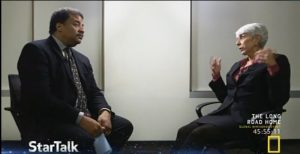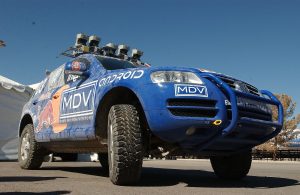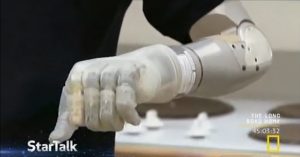Last Sunday night, 5November17, the National Geographic channel broadcast the latest episode of their series ‘Star Talk’, the ‘Intersection of Science and Popular Culture’ with host Neil deGrasse Tyson. As always the show centered around a taped interview by Dr. Tyson with a guest of some importance in some field of science. Last night’s guest was Doctor Arati Prabhaker who recently stepped down from her position as the Head of the Defense Advanced Research Programs Agency or DARPA. The picture below shows Dr. Tyson with Dr. Prabhaker.

The interview began with Dr. Tyson asking Dr. Prabhaker to describe what DARPA is and relate a bit about its history. DARPA was formed in 1958, in the wake of the USSR’s launching the first artificial satellite Sputnik I, as an agency within the Department of Defense assigned with finding ways to adapt the latest technology to our nation’s military readiness.
Over the years DARPA has had a few amazing successes such as ‘Stealth’ radar invisible aircraft and precision guided ‘Smart Bombs’ but not all of DARPA’s work has involved weapons. In fact some of the agency’s breakthroughs have been turned into many of the hi-tech devices we use everyday. One DARPA program called ‘ARPA net’ developed many of the protocols that computers use to talk to each other, a critical part of the Internet. Also, I was personally a witness to DARPA’s funding of the development of Gallium Arsenide (GaAs) as a semiconductor material for high frequency circuits; you wouldn’t have a cell phone without it.
In fact some of the technology currently being supported by DARPA has already been discussed on this blog in previous posts. The DARPA challenge race for driverless cars was the main topic of my post of 17Jun17. Meanwhile DARPA’s funding has also helped to advance the engineering of prosthetic limbs for wounded soldiers, some of the results of which were discussed in my post of 23Sept17. The images below show some of the results of DARPA’s support in these fields. The first is from the driverless vehicle challenge while the second shows the latest result of prosthetic engineering and which is currently undergoing clinical trials by the Food and Drug Administration.


While Dr. Tyson’s interview with Dr. Prabhaker was taped earlier several guests joined Neil in his studio at the Hayden planetarium. One was his usual sidekick the comic Chuck Nice who seemed unnaturally nervous while trying to make jokes about military weapons systems. The second guest was the journalist Sharon Weinberger who has reported about DARPA for 17 years and has written a book ‘The Imagineers of War’ about DARPA. The cover of ‘The Imagineers of War’ is show below.

The episode’s final guest, Hod Lipson is a Mechanical Engineer who took part in DARPA’s road challenge with a team from Cornell University and who has written about the coming revolution in driverless cars appropriately titled ‘Driverless’. Both books are available at Amazon. The cover of ‘Driverless is shown below.

At the end of every episode Dr. Tyson makes a few concluding comments. A few of the things he said last night bear repeating. First Neil suggested that there should be a DARPA type of agency ‘in every branch of human culture’. But the comment that I think we would all do well to consider was ‘at DARPA they take risks, risks that other sources of money do not take. Well the day you stop making mistakes is the day you can be sure you are not on the frontier.”
